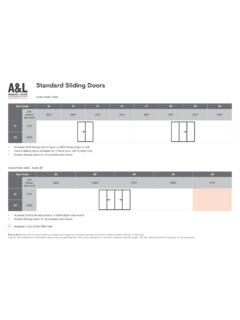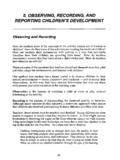Transcription of AS1288 Glass Guide - A&L - Windows
1 Murray Art Museum (MAMA)Source: DLG Aluminium & GlazingGUIDE TO Glass AND GLAZINGAUSTRALIAN WINDOW ASSOCIATION Guide SERIESA HANDBOOK TO AS 1288 VERSION 2 2016 castle Circuit, Seaforth, NSWS ource: Evolution Window Systemsii CONTENTSCONTENTS iiFOREWORD ivACKNOWLEDGEMENTS ivABOUT AWA vDISCLAIMER vABOUT Glass 1 Glass TYPES 3 Float Glass 3 Tints and Tones 4 Decorative Glass 4 Low-E Glass 4 Insulating Glass Units 4 Safety Glass 5 Toughened Glass 6 Heat Strengthened Glass 7 Laminated Glass 7 Glass STANDARDS 8AS 1288 Glass in Buildings Selection and Installation 8AS/NZS 2208 Safety Glazing Materials in Buildings 8AS/NZS 4666 Insulating Glass Units 8AS/NZS 4667 Quality Requirements for Cut-To-Size and Processed Glass 8AS/NZS 4668 Glossary of Terms Used in the Glass and Glazing Industry 8 OTHER REGULATORY REQUIREMENTS 9 The National Construction Code 9AS/NZS 1170 Series Structural Design Actions 9AS 4055 Wind Loads for Housing 9AS 2047 Windows and External Glazed Doors in Buildings 9AS Swimming Pool Safety
2 Part 1 Safety Barriers for Swimming Pools 9 DESIGN FOR WIND LOADS 11 Regional Wind Speed 13 Terrain Category 13 Local Topography 13 Building Height, Shape and Orientation 14 The Effects of Shielding 14 Span of Glazing 14iii Australian Window Association VERSION 2A Guide TO Glass AND GLAZINGCONTENTSHUMAN IMPACT SAFETY 17 Critical Locations 18 Making Glass Visible 18 Doors and Side Panels 19 Glazing Capable of Being Mistaken for a Doorway or Opening 20 Low Level Glazing and Windows that are Full Height 20 Bathroom, Ensuite and Spa Room Glazing 20 Glazing in Stairways 20 Internal and External Shopfronts and Partitions 21 Schools, Early Childhood Centres, Aged Care Buildings and Nursing Homes 21 Insulating Glass Units 21 SLOPED OVERHEAD GLAZING 23 GLAZING FOR BALUSTRADES AND POOL FENCING 25 Balustrades 25 Swimming Pool Fences 25 FRAMED.
3 UNFRAMED AND PARTLY FRAMED Glass ASSEMBLIES 27 SHOWER SCREENS 29 ENERGY EFFICIENT GLAZING 31 About Energy Efficiency 31 Energy Efficient Glazing Assessment 32U-Value 32 Solar Heat Gain Coefficient 32 Visible Transmittance 32 Energy Efficiency of Glass 32 Energy Efficiency of Window Systems 32 Regulatory Requirements 33A Guide to Selection 33 Condensation on Glazing 34 ACOUSTIC GLAZING FOR NOISE ATTENUATION 37 Measurement of Sound 37 Regulatory Requirements 38 Acoustic Performance of Glass 38 High Performance Solutions 39 Noise Reduction by Glass Type 39 GLAZING IN BUSHFIRE PRONE AREAS 41 BAL Testing 42 Glass INSTALLATION 45 Safe Handling of Glass 45 Preparation and Planning 46 Sealants 46 Dry Glazing 47 Wet Glazing 49 Butt-Joint Glazing 49 Structural Silicone Glazing 50 Setting Blocks 50 Laminated Glazing Materials 51 Insulating Glass Units 51 Installation of Glass 51 Glass CUTTING AND PROCESSING 53 DEFECTS IN Glass 58 Feathering 58 Shells 58 Scratches 58 Starts and Runs 58 NICKEL SULPHIDE AND HEAT SOAKING OF TOUGHENED Glass 59 THERMAL STRESS Glass BREAKAGE 60 Risk Factors 60 CARE AND MAINTENANCE OF Glass 61On-Site Protection 61 Cleaning 61 Notes 61 APPENDIX A.
4 Glass THICKNESS Guide TABLES FOR WIND RATINGS ONLY 63 APPENDIX B: REFERENCED DOCUMENTS 79 APPENDIX C: GLOSSARY OF TERMS 80 LIST OF IMAGES AND TABLES 88iv A Guide TO Glass AND GLAZINGA ustralian Window Association VERSION 2 This handbook has been written to provide guidance for architects, building designers, engineers, fabricators, glaziers and associated industry professionals on the proper use and application of Glass in the building and construction is one of the most practical, versatile and interesting building products. Despite its transparent nature, glazing, when used to its full potential, is often the most extraordinary architectural feature of a building. It can add interesting and unique elements to any building - adding character and improving the form and function of a space. Glazing also provides significant benefits to building occupants through the use of natural light, creating a feeling of openness and providing expansive views of the outside has a major impact on energy consumption.
5 If applied improperly, it can be a significant source of heat gain and loss. However, when selected carefully, Glass can be used in such a way as to dramatically enhance a building s energy today s built environment, glazing does far more than keep out the wind and rain (although these have always been its primary function). It has become increasingly important to consider the design, selection and installation of glazed elements. Performance characteristics such as safety, energy efficiency, acoustic attenuation and fire protection are but a few of the functions a well-considered glazing system can this end, advances in technology have made available a host of new and exciting glazing products; high performance double and triple glazing systems, spectrally selective films and Low-E coatings, and specially developed acoustic laminates to name a this handbook includes references to a number of Australian Standards and the National Construction Code, it is not, nor is it intended to be, a definitive prescription of the regulatory framework.
6 This handbook provides guidance for the most common applications of Glass and glazing and serves as an overview of current industry practice. The correct and proper assessment of glazing requirements requires a thorough understanding and application of the relevant Australian Window Association (AWA) would like to acknowledge the contribution of the following in the preparation of this Guide : AWA Technical Committee Australian Fenestration Training Institute (AFTI)Special thanks to: Australian Glass Group DLG Aluminium & Glazing Overseas Glass Agencies SCM Group Australia Viridianv Australian Window Association VERSION 2A Guide TO Glass AND GLAZINGWith over 600 member companies, the AWA is the peak association representing window and glazing manufacturers and their suppliers. It is a co-operative; all members have one vote irrespective of size and financial contribution.
7 The Association Business Plan is monitored and reviewed by an elected Board representing all states and territories of Australia. The AWA provides a national technical voice through representation on Australian and International Standard Committees, the Building Code Committee, Residential and Commercial Building Regulation Committees and Committees for Mandatory Energy Requirements. It keeps the window industry informed via magazines, website updates, meetings, conferences and industry exhibitions and promotes the industry through media outlets, trade exhibitions and presentations at industry AWA manages NATA accreditation and compliance programs for manufacturers, provides comprehensive proprietary training and technical support documents through its training division the Australian Fenestration Training Institute (AFTI), handles dispute resolution with consumers, and owns the Window Energy Rating Scheme (WERS)
8 That provides the industry with energy ratings for their fenestration AWA continues to work relentlessly, representing the industry in as many forums and on as many work groups and committees as they practically can, on all industry AWADISCLAIMERThis Guide has been developed to provide general guidance, awareness and education to AWA members, stakeholder groups and consumers. It should not be viewed as a definitive Guide . While every effort has been made to ensure the information is accurate, the AWA expressly disclaims all and any liability to any person for anything done in reliance on this publication. No responsibility is accepted by the AWA for any mistakes, errors or omissions in this Street, Norman Park, QLDS ource: Bretts Architectural Window Solutionsvi 1 Australian Window Association VERSION 2A Guide TO Glass AND GLAZINGG lass is made by melting together several minerals at very high temperatures.
9 Silica, in the form of sand, is the main ingredient and is combined with other substances to form a batch and melted in a furnace at temperatures of 1500 C. The basic raw materials include: Former: Silica (quartz sand). Fluxing agent: Lime and soda ash (sodium carbonate). Stabiliser: Calcium oxide (CaO), magnesium oxide (MgO), alumina, etc. Cullet: Broken Glass is also used in the batch to speed up the melting process. Other materials that are added to produce different colours or properties as GLASSF igure 1 Glass CompositionSource: ShutterstockOther (Cullet, Stabiliser, etc.)LimestoneSoda AshSandWindow ProfileSource: Shutterstock2 Batching Raw MaterialsMelting FurnaceRefining FurnaceFloat BathAnnealing LehrInspection & CuttingPackingBatching Raw MaterialsMelting FurnaceRefining FurnaceFloat BathAnnealing LehrInspection & CuttingPacking3 Australian Window Association VERSION 2A Guide TO Glass AND GLAZINGGLASS TYPESFLOAT GLASSIn the batch process, the raw materials are mixed, then fed together with suitable cullet in a controlled ratio, into a furnace where it is heated to approximately 1500 C.
10 The principal reactions between the raw materials take place within the melting zone, which occupies about a third of the tank. The melting process is crucial to Glass quality. Once molten, the Glass then flows in a continuous ribbon from the Glass furnace onto a bath of molten tin. The Glass , which is highly viscous, floats on top of the flat surface of the tin to form perfectly smooth surfaces on both the top and bottom with uniform thickness. This is where the name float Glass comes from. As the Glass flows along the tin bath, the temperature is gradually reduced until the sheet is sufficiently solidified and can be transferred (at a controlled speed) from the tin onto rollers. Variation in the flow speed and roller speed enables the formation of Glass sheets of different thicknesses. Once off the bath, the Glass sheet passes through an annealing chamber called a Lehr where it is cooled gradually to avoid strain and cracking from the temperature change.







